Lab-to-Lab: US-Russian Lab-to-Lab Collaboration Story [Archived]
- Home
- Joint Verification Experiment
- Science Collaboration
- Nuclear Materials
- Nuclear Weapons
- Nuclear Experts
- What’s New
Fundamental science remained crucial to both American and Soviet nuclear programs throughout the Cold War and, not surprisingly, it became the focus of the first post-Cold War nuclear cooperation. The collaboration on the Joint Verification Experiment (JVE) in 1988 was the first direct, face-to-face encounter. The JVE contacts and subsequent Geneva Threshold Test Ban Treaty negotiations led in 1990 and 1991 to the initial visits of Los Alamos and Lawrence Livermore scientists to the Russian closed cities of Sarov and Snezhinsk, homes of VNIIEF and VNIITF, respectively. These in turn led to the first nuclear weapons laboratory directors exchange visits in February 1992.
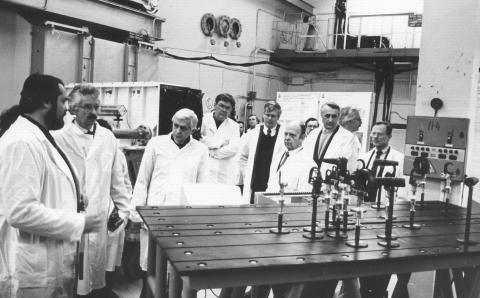
US lab directors tour scientific facilities in VNIIEF. Sarov, February 1992
In these early visits, plans for scientific cooperation were proposed and discussed. It took some time to persuade the government agencies and work out the mechanics. Less than two years since the lab directors exchange, scientists from the Russian Federal Nuclear Center-VNIIEF in Sarov and the Los Alamos National Laboratory (LANL) conducted path-breaking scientific experiments behind the security fences of each laboratory.
One of the first areas explored was in the general field of pulsed power. The two labs have conducted more than 25 joint experimental campaigns at LANL and VNIIEF. This collaboration has covered many research areas where pulsed-power-driven experiments could make a unique scientific contribution, such as high-current generation and switching, plasma and condensed liner physics, solid-state physics in high magnetic fields, magnetized plasma and fusion physics, soft x-ray generation, hydrodynamic and magneto-hydrodynamic instabilities, dynamic material strength properties, material shock damage and spall studies, warm dense matter, and other areas in high-energy-density physics. The joint work resulted in more than 400 papers.
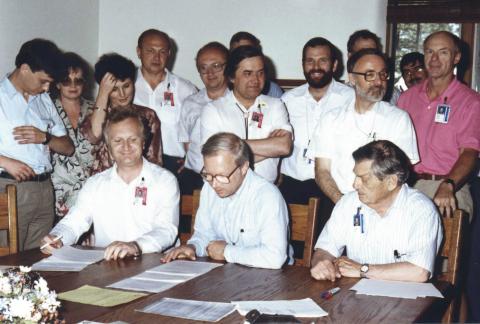
Viktor Selemir of VNIIEF and Steve Younger and Max Fowler of LANL sign collaboration contracts. Los Alamos, 1993
Another quick-start receiving early approval was computer modeling and simulation where US and Russian labs combined the strengths inherent in their computational traditions to the great benefit of both sides. The approved scope for lab-to-lab scientific cooperation remained fairly narrow until the signing in 1996 of the Reis-Ryabev protocol significantly broadened the possibilities for technical engagement. Within a few months of the protocol signing, the three US and three Russian nuclear weapons labs had hammered out a rich menu for expanded scientific collaboration, including joint work under the umbrella of “Computations, Experiments, and Materials.”
A critically important aspect of scientific cooperation was that scientists on both sides longed for doing something new, constructive, and exciting together. Washington’s primary driver for engaging the Russian nuclear complex was to prevent bad things from happening—no accidents, no nuclear materials theft or diversion, no brain drain or potential loss of nuclear weapon expertise. But for scientists, the excitement is in creating new scientific knowledge or developing new technologies. The attraction to do together the new and exciting science drove collaborations which involved hundreds of scientists, engineers, and technicians. These joint scientific endeavors helped gain respect and trust and built the relationships that paved the way for tackling the more sensitive matters that emerged at the Cold War’s end.
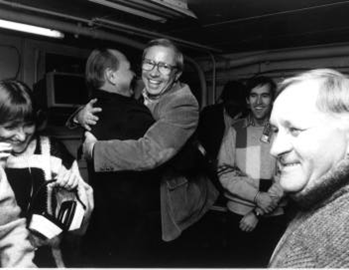
Alexander Bykov hugs Steve Younger after a successful experiment
In the words of participants
After laboratory overviews from both sides, VNIIEF scientists described some of the most exciting, leading edge research in areas of fundamental science that underpin the nuclear weapons program. It was these three days that convinced me that we not only should collaborate with the Russian nuclear institutes but that we must. Upon my return to Washington, I reported that, based on the scientific excellence we found at the Russian institutes, we concluded that they knew every bit as much about nuclear weapons as we did. Therefore, as we developed scientific collaborations we needed only to guard our national security secrets, but we did not have to be concerned about giving away our scientific knowledge. I believed that we could learn as much from them as they could learn from us.
Sig Hecker, LANL Director
At a banquet celebrating the success of the first joint LANL/VNIIEF experiment in September 1993, VNIIEF’s Yuri Trutnev presented certificates to the participants and stated “all of you can be sure your children and grandchildren will be proud and this is the beginning…” For the authors and most, if not all, of the LANL members of the collaboration, the opportunity to participate in the LANL/VNIIEF collaboration was one of the highlights of their careers. Each participant in this unprecedented collaboration has accumulated a lengthy string of memories. Trutnev was absolutely right: for all, the personal experiences will be repeated over and over to anyone who will listen.
Irv Lindemuth, LANL
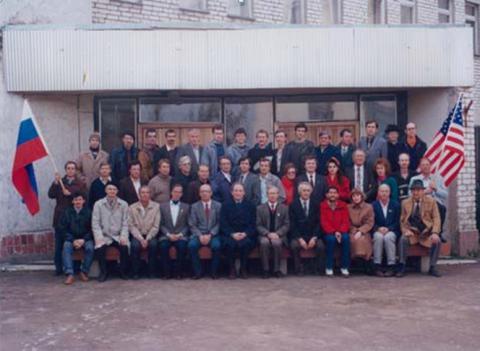
Russian and American scientists after the first VNIIEF-LANL experiment. Sarov. 1993
Find in the book
Chapter 8 of Volume II captures the stories of collaborations and discoveries by Evgeny E. Meshkov (VNIIEF), Irvin R. Lindemuth and Robert E. Reinovsky (LANL), Sergey F. Garanin (VNIIEF), Siegfried S. Hecker (LANL) and Lidia F. Timofeeva (VNIINM), Boris A. Nadykto (VNIIEF), Dean Preston et al.(LANL-VNIITF), Frank J. Cherne et al.(LANL, VNIIEF, VNIITF), Dale E. Nielsen, Jr. (LLNL), Rashit M. Shagaliev et al. (VNIIEF), Georgy N. Rykovanov et al.(VNIITF), Sergey N. Abramovich et al.(VNIIEF), David L. Clark (LANL), and Vadim A. Simonenko (VNIITF).
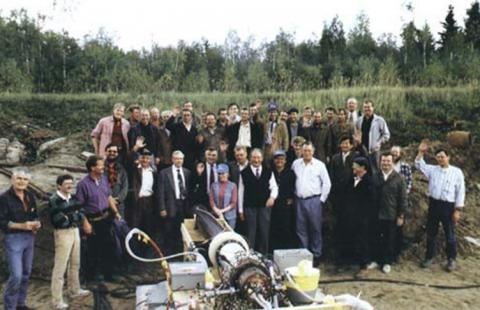
The Russian and American participants of MAGO-II experiment with the MAGO and DEMG assembly at the forefront. Sarov, 1994.
Documents
Proposals of VNIIEF, VNIITF and LANL, LLNL for collaboration. February 1992. Proposals of the Nuclear Weapons Institutes of the Russian Federation, VNIIEF and VNIITF, and US National Laboratories, LANL and LLNL, for collaboration in the fields of surety, reduction, and nonproliferation of nuclear weapons, and scientific research. Memorandum based on exchanges during February 1992.
Summary of the U.S. and Russian Nuclear Design Labs Exchange Visit of February 1992. Presentation to Admiral James D. Watkins. March 2, 1992.
Russian-American Collaboration. The transition to peacetime work. Steven M. Younger, Los Alamos Science, N 21, 1993.
